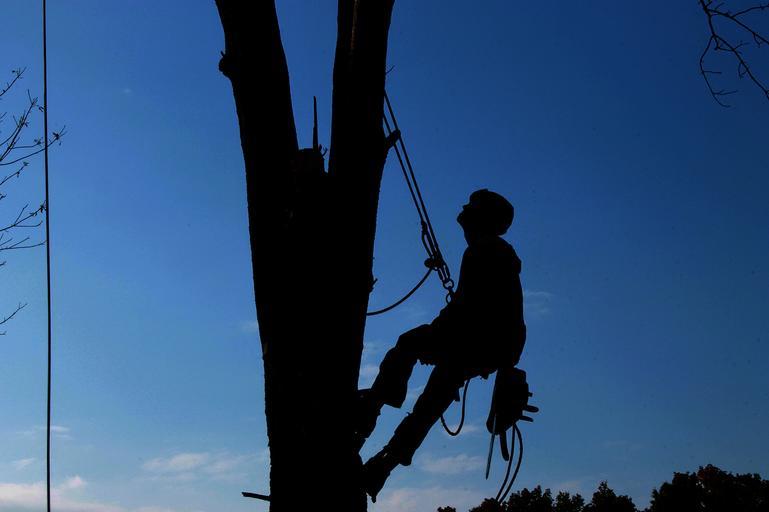Inland Tree Care Company
Tree Cabling Service in Riverside, CA
What is tree cabling in the first place?
Sometimes an established tree will grow in a way that it won't be able to sustain if the problem is not corrected. In these situations, skilled tree service professionals will use cables to stabilize the tree, and save it.
Trees tend to grow wherever there is the most available light. In environments like we have in the Inland Empire, there is an abundance of light, and sometimes the limbs of a tree will grow to the point where they are "overextended." You can tell when this is happening because the limbs will have extended beyond the canopy of large shade trees.
Eventually, these overextended limbs will continue to grow until they can no longer support the weight of their canopy. If these trees were not pruned properly in the past, they can have weak branch unions, often with bark embedded in the branch union, which causes further weakness. Large limb failure due to these circumstances can be dangerous.
And we also must remember that trees aren't growing with our homes in mind. Sometimes they can grow in directions that are perilous for our residences or commercial establishments. These are just a few reasons why proper tree pruning is important.
If you're in need of tree cabling services, or you're unsure of whether it's the right option for you, please
call us today at (951) 900-3454 for an inspection.
When Tree Cabling is Necessary
There are a number of reasons why cabling might be the correct decision to save a tree. Here are a few to get us started:
Human Safety
Before you know it, a large and unstable branch could be hanging over a sidewalk or the walkways leading up to your front door. I'm sure we don't have to tell you that this poses a major risk to your family, guests, delivery men and women, or any other passersby. Worst case scenario, they could even sue you if a branch were to fall and injure them.
Property Safety
As mentioned earlier, trees tend to grow towards light. Sometimes, that source of light could end up being directly above your home. In these cases, cabling could be necessary to ensure that no large branches will fall on your house.
Tree Health
Trees have surprisingly similar characteristics to humans. If we get a wound that is left untreated, it can become infected. A tree with a trunk that is compromised--or wounded--can become infected with harmful fungi that wreak havoc on the health of your tree.
Appearance
Everyone loves having a beautiful, majestic tree in their yard or on their property. A lost limb may seem like small potatoes, but it can actually cause your tree to appear lopsided and kind of wonky. For a large tree that has been growing for decades, this is a major, irreparable blow.
Riverside Tree Cabling FAQs
- Can't I cable my tree myself?
As is the case with most tree care tasks, this is not something that should be attempted by an untrained property manager or homeowner. Health and structure of the tree--along with tree aesthetics, risk reduction and tree preservation--will need to be assessed by a certified arborists before any work begins on the tree. If done improperly, the cables can be positioned incorrectly, resulting in girdling. Girdling happens when a cable is wrapped around a tree trunk in a way that strangles it, choking off the flow of nutrients. Whenever we introduce a material to nature that...well...isn't natural, we risk damaging it. For the benefit of the tree and the best likelihood of saving it, this service should be performed by certified arborists.
- How is tree cabling done?
This can be a complex process, but we'll give you the general idea.
Holes are drilled in the trunk or branches of the tree, and then the certified arborist will insert the cable. Then, the cable is secured properly to keep it taught.
- What's the difference between cabling and staking?
Staking trees involves anchoring them to the ground. When it comes to cabling, the entire process is done above the ground. Tree cabling is also meant to provide long-term stability, often for the rest of the tree's life. Staking is only meant to be a temporary solution. You might notice that when you visit a brand new community, the young trees are always stalked to get them off to a proper start. If a "sapling" were to start leaning early on, it will continue to grow crooked. Once the new tree is properly established, the stalks are removed and the tree will continue its growth.
- Can I have my tree pruned instead?
Tree pruning is something that should be done as regular maintenance, to reduce the likelihood of failure of a tree in the future. When a tree is in need of cabling, there are often greater issues at hand, some of which can not be seen on the surface. Cabling is recommended for support for limbs where pruning might not help strengthen the structure of the tree.
- Will I be able to have the cables removed eventually?
If tree cables have been installed because a branch was growing at a bad angle, they are almost never removed. The cable will probably have to be there permanently. Branches can't simply take the hint and stop growing at that unsustainable angle, and it will always be an issue. So the supporting wire will always be needed and should not be removed. If done properly, by a certified tree care professional, there will be no harm in leaving the cable inside of the tree.
- So I got my tree cabled...now what?
Regular inspection of the cables is necessary. We recommend scheduling a service with a certified arborist annually to come and visually inspect the cables. And every five years, we recommend a more in-depth climbing inspection be performed. This does not mean that the cables will need to be replaced at this time. Depending on the weather conditions of the area and other factors, cables should be good for 20-40 years. However, it is always a best practice to have the cable, hardware, and tree parts inspected regularly to ensure that everything is still in good working condition.
Call to hire a pro
| (951) 900-3454
Inland Tree Care Company
The leading professional tree service providers in Riverside, CA.
Services
Service Areas
The Inland Empire's leading tree care professionals since 1991.
6296 Magnolia Ave
Riverside, CA 92506
We're available
- Mon - Fri
- -
- Sat - Sun
- Closed
We are a third party referral company. All referrals are forwarded to a licensed, professional tree service provider in Southern California.



